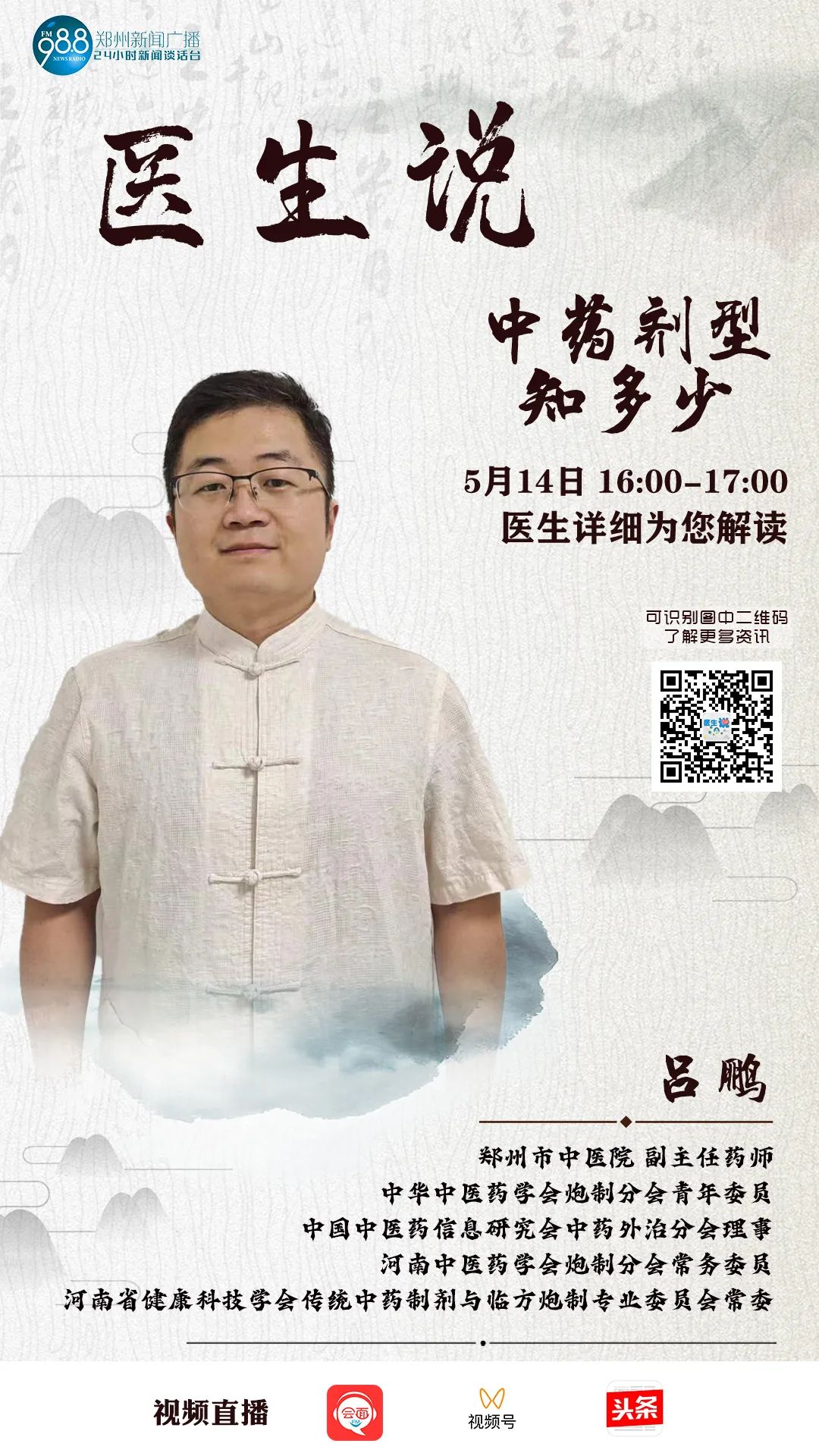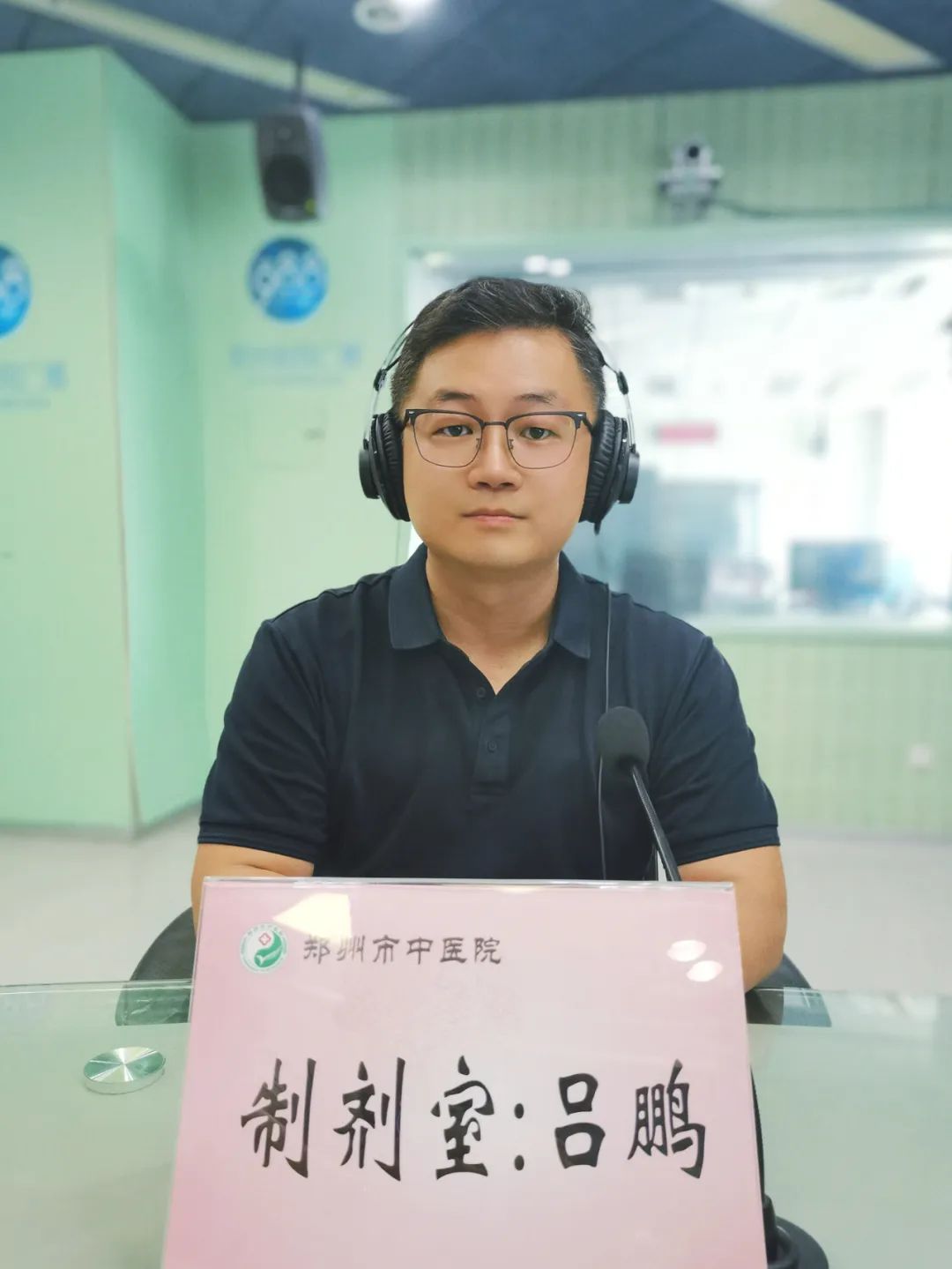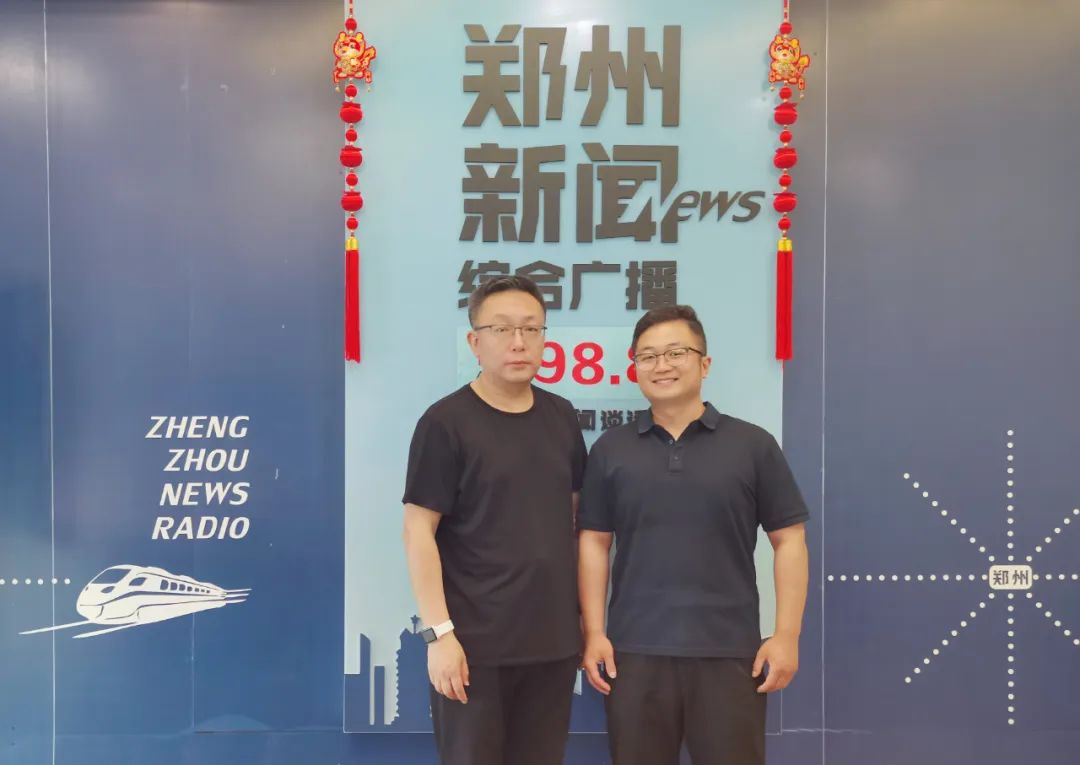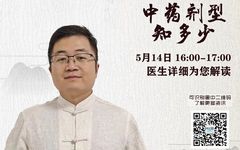On May 14, Lu Peng, the deputy chief pharmacist of Zhengzhou Traditional Chinese Medicine Hospital, appeared on the program “Doctor Says” to discuss “How Much Do You Know About Traditional Chinese Medicine Forms?”

01What is the Form of Traditional Chinese Medicine??
When mentioning Traditional Chinese Medicine (TCM), one often thinks of decoctions; however, TCM includes various forms such as pills (wan), powders (san), pastes (gao), and elixirs (dan). The form of TCM is the carrier of TCM preparations, referring to the various styles of TCM made for internal or external use, based on the composition of the TCM formula, the medicinal properties, dosage, and intended use, processed through specific methods.
The form originates from the “formulas”. In the “Huangdi Neijing”, the Yellow Emperor often said, “Please present the formula.” The “form” represents principles; the ancients spoke of “round and square”, where “round” signifies flexibility and “square” signifies principle. So what is “form”? After differentiation, a principle is established, and there must be a form of medicine that is most suitable for the condition, which is the “form”. The process of determining the formula, medicine, form, dosage, and treatment duration is the implementation of TCM’s “theory, method, formula, and medicine”.
During the Northern Song Dynasty, the Taiyi Bureau established the Shuyuan, which was the first state-run pharmacy in Chinese history. Its establishment marked the official beginning of the TCM preparation industry in China, laying the foundation for the production and development of TCM preparations. The Shuyuan emphasized the quality of medicinal materials and the standardization of production processes, ensuring the safety and effectiveness of TCM preparations, providing important experience and examples for the development of the TCM preparation industry. The “Taiping Huimin Heji Ju Fang” is the first national pharmacopoeia in Chinese history, containing many practical prescriptions and preparation methods, marking a milestone in ancient Chinese medicine. In the “Taiping Huimin Heji Ju Fang”, different TCM forms and dosages are specified for various diseases and symptoms, including pills, powders, pastes, elixirs, and wines, enriching the variety of TCM forms and providing standards and guidance for the production and use of TCM preparations.
02What are the Forms of Traditional Chinese Medicine?
(1) Traditional TCM Forms
① Decoction: Decoctions are made by soaking, boiling, and filtering the TCM ingredients in water, which are then consumed directly. They are primarily used for internal consumption but can also be used externally for steaming, washing, and gargling.
② Wine Preparation: The prepared TCM is soaked in white or yellow wine for a period, allowing the medicinal properties to infuse into the wine. The residue is removed, and the clear liquid is used for treatment. It generally has effects of dispelling cold and promoting blood circulation.
③ Tea Preparation: Tea preparations involve grinding TCM materials into coarse powder, which is then made into blocks or powder for daily consumption through brewing.
④ Distillate: TCM is distilled in water, and the collected distillate is the medicinal liquid. This form typically contains volatile aromatic components, resulting in a pleasant aroma and taste.
⑤ Pills: The ingredients are ground into fine powder, and various “binders” such as water, honey, rice paste, medicinal juice, or flour are added to form pill-shaped medicines. They are generally used for the conditioning of chronic disease patients.
⑥ Powder: Powders are made by grinding the medicinal ingredients into fine powder and mixing them evenly. They are characterized by rapid action, quick absorption, and convenience for carrying, suitable for both internal use and external application.
⑦ Paste: Pastes can be for internal or external use. Internal pastes are generally suitable for chronic deficiency syndromes. External pastes can be divided into plasters and ointments. Plasters are typically used for treating injuries or conditions related to wind-cold pain, while ointments are used for treating rhinitis, eczema, and ulcers.
(2) Common Modern TCM Forms
① Oral Liquid: Oral liquids are developed based on decoctions. They are prepared using different extraction methods based on the effective components of the medicinal ingredients. They not only have the advantages of good absorption and rapid effect like decoctions but are also convenient to use, require smaller doses, and have a pleasant taste, making them easy for patients to accept.
② Granules: Granules are made by processing the medicinal ingredients through crushing or extracting effective components and mixing them with suitable excipients to form dry granules. Granules have the advantages of rapid absorption like decoctions, while also being convenient for carrying and storage. However, they can be prone to moisture absorption and quality changes.
③ Tablets: Tablets are made by mixing fine powder or TCM extracts with excipients and compressing them into solid forms. Tablets have accurate dosages, stable quality, and are convenient for use and carrying. However, their absorption is slower, and tablets containing volatile components may lose potency if stored for long periods.
④ Capsules: Capsules are solid preparations filled with medicinal ingredients and excipients in hollow capsules. They are characterized by strong stability, easy absorption, and convenience for use, while the capsule shell masks any unpleasant odors of the medicine.
⑤ Injection: TCM injections are made by extracting the effective components of the medicine and preparing them into sterile formulations for intramuscular or intravenous use. They have rapid efficacy and play a unique role for critically ill patients who cannot take oral medications. However, the preparation of TCM injections requires high standards, and due to the complexity of TCM components, doctors must enhance monitoring and use them cautiously.

03How to Choose the Right TCM Form?
(1) Choose TCM Forms Based on Efficacy
Chinese medicine has created various forms through long-term clinical practice, such as decoctions, pills, powders, pastes, elixirs, and wines, to meet the treatment requirements of different diseases. Modern TCM preparations are more complex, with varying effects. Decoctions are commonly used for internal consumption due to their rapid absorption and quick efficacy; honey pills are absorbed slowly and are suitable for patients with cough symptoms and those needing tonification; powders have special efficacy for ulcers; plasters are used externally for protection, moisturizing the skin, anti-inflammatory, astringent, and antibacterial effects, with mild and lasting efficacy, often used for rheumatic pain, injuries, and skin ulcers; wine preparations have effects of promoting circulation and tonifying the kidney, suitable for patients with rheumatic pain and injuries; gels rich in hydrolyzed proteins and amino acids are often used for tonifying, especially suitable for those who are weak after prolonged illness; granules are absorbed quickly and are often used for acute diseases, especially suitable for children; injections are used for intramuscular or intravenous administration, with rapid efficacy, suitable for acute or critical conditions.
(2) Choose TCM Forms Based on Condition
In traditional Chinese medicine, there are various types of TCM preparations, and patients often feel confused about which form to choose. Clinicians often select appropriate TCM forms based on the patient’s constitution and condition. Details are as follows.
For patients with acute or critical conditions, TCM decoctions are more effective. Decoctions have great flexibility in composition, allowing for adjustments based on symptoms, and have high comprehensive efficacy, making them the most widely used form in clinical practice.
For patients with chronic diseases who are often in a state of deficiency, pills are easy to use. Pills have a mild effect and long-lasting efficacy.
Tablets are suitable for both acute and chronic patients due to their accurate dosage and convenience for carrying and use.
For special patients, such as children or those who dislike bitter medicines, granules are suitable. Granules dissolve easily in hot water for quick absorption and may have a sweet taste. Additionally, syrup preparations, made from medicines and sugars, are often used for cough relief and are also suitable for these patients.
Chronic disease patients can choose internal pastes, commonly used for tonifying and cough relief, such as Shiquan Dabu Paste and Snow Pear Paste. For conditions like rheumatic pain, injuries, and skin ulcers, external pastes such as Dogskin Plaster and Blood-Activating Pain-Relieving Plaster can be selected.
For patients with rheumatic pain and injuries, medicinal wine is also suitable. Medicinal wine has the function of promoting circulation and can be taken internally or applied externally.
For acute or critical patients, injections can be chosen for emergency treatment, as the medicine enters the body quickly through intramuscular or intravenous injection, providing rapid action, such as Chaihu Injection and Compound Danshen Injection.
04What are the Characteristics of TCM Preparations?
(1) Different Forms Have Different Onset Speeds
“Decoctions are for major diseases; powders are for acute diseases; pills are for mild treatment” (Li Dongyuan); “If the disease is severe, decoctions should be used; powders may not be sufficient” (from “Su Shen Liang Fang”); “For newly onset diseases, decoctions are often used; for chronic diseases, fermented liquors are used” (from “Sheng Ji Zong Lu”). From the above discussions, it is clear that the ancients often selected corresponding rapid or slow-release preparations based on the urgency of the disease and the toxicity of the medicine.
Generally, for urgent and severe conditions, the ancients often chose decoctions or powders that dissolve well, absorb quickly, and act rapidly. For example, using Ren Shen Fu Zi Decoction for critical conditions of severe qi deficiency and sudden yang collapse, the effect is swift to achieve the goal of “reviving yang in the gate of life” (from “Shan Bu Ming Yi Fang Lun”). For mild and chronic diseases, the ancients often used pills or pastes that release their medicinal power gradually in the gastrointestinal tract for sustained effects. For prescriptions containing toxic or irritating medicines, the ancients usually prepared them into pills using binders like rice paste, flour, or wax to delay absorption and reduce adverse reactions and gastrointestinal irritation. For toxic medicines, Li Dongyuan often used wax as a binder to make pills to achieve the goal of “toxic medicines do not harm the spleen and stomach”.
(2) Using Different Forms to Control the Action of Medicines
The ancients often used different forms to control the action of medicines. For internal preparations, they believed that decoctions could reach both the interior and exterior of the body, suitable for both exterior and interior diseases; while pills and powders were more for internal use, mainly for interior conditions. For local diseases, they often selected external preparations to achieve the goal of “attacking evil nearby”. For example, throat medicines, nail medicines, nasal medicines, and ear drops; additionally, the ancients often used special methods of taking medicine to control the action of medicines. For diseases above the chest, they often took medicine after meals. For example, Chuanxiong Cha Tiao San for wind-evil headache and Huagai San for lung diseases are taken this way. Conversely, for diseases below the chest, they took medicine before meals.
(3) External Treatment Methods in TCM
Traditional Chinese medicine believes that the human body is an organic whole. The surface and internal organs are parts of this whole, interrelated in function and mutually influential in pathology. Therefore, treatment applied externally can also affect the internal organs; treating locally can also reach the whole body. The overall effect of external treatment methods refers to the medicines applied to the body surface that can penetrate through the skin, reaching the internal organs through the circulation of qi and blood in the meridians, spreading throughout the body to exert corresponding effects. The ancients used pastes (including hard and soft pastes), tablets, etc., applied to the affected areas or acupoints, allowing the medicine to be absorbed slowly and exert lasting effects for treating both local and systemic diseases.

05How to Choose Forms for Pediatric Medication?
Children have delicate organs, and their absorption, metabolism, and tolerance to medications differ significantly from adults. However, the phenomenon of adult-like medication use in children is common, making medication safety difficult to guarantee.
① Powders: Powders are used for acute diseases, characterized by rapid efficacy and easy dosage adjustment. For example, our hospital’s Xiaogang Jisan has effects of strengthening the stomach, regulating qi, promoting digestion, and stopping diarrhea, suitable for symptoms like poor appetite, pallor, fever, night sweats, indigestion, abdominal distension, and diarrhea. However, powders still have certain shortcomings in product quality and patient compliance; the bitter taste and gritty texture of TCM powders are not conducive to children’s medication, often requiring large amounts of water, which can lead to choking, thus requiring improved masking techniques to enhance compliance.
② Granules: Granules retain the rapid absorption and efficacy of traditional decoctions while overcoming the inconveniences of carrying, large doses, and poor stability. However, attention should be paid to the size, shape, and quantity of granules to avoid the risk of aspiration in children; additionally, granules should be packaged according to the smallest age-appropriate dosage. For example, our pediatric department commonly uses Chai Ge Jie Re Granules, San Xian Xiao Ji Granules, Ye Ju Jie Du Granules, Xiao Er Ma Xing Granules, Sang Ju Jie Biao Granules, Jing Fang Jie Biao Granules, and Xuan Chang Tong Qiao Granules, improving the accuracy of dosages compared to previous practices of using adult-packaged medicines for children.
③ Tablets: Chewable tablets should be prioritized, as they need to be chewed in the mouth to produce a pleasant taste before swallowing, which can improve children’s compliance. Due to safety concerns, clinical experts do not recommend effervescent tablets for children.
④ Pills: With the development of preparation technology, the pill form has continuously innovated. For example, micro-pills with a diameter of less than 2.5mm, such as Wang’s Bao Chi Pills, can promote digestion and strengthen the spleen, suitable for children with milk stagnation and spleen deficiency. Our hospital’s Xiao Shi Wan has effects of strengthening the stomach and generating fluids, suitable for all cases of milk stagnation and food accumulation causing poor appetite, vomiting, and weight loss. The method of administration is to dissolve in the mouth, making it an important alternative for infants who cannot swallow tablets.
⑤ Oral Liquid Preparations: These include mixtures, oral liquids, syrups, and other liquid forms, retaining the convenience of traditional decoctions, rapid absorption, and flexible dosing. For example, our hospital’s Jing Fang Bai Wen Mixture has effects of relieving cough, dispelling wind, and stopping pain, suitable for symptoms of cold and dampness affecting the lungs, such as chills, fever, headache, body aches, nasal congestion, runny nose, cough, white phlegm, sore throat, and heavy voice. It can also be used for influenza and common colds, making it a common form for pediatric medication, especially suitable for children who cannot swallow solid preparations.
⑥ Inhalation Preparations: The effective components or parts of TCM can be extracted and refined into aerosols or sprays, delivering the medicine to the lungs through the respiratory tract for local or systemic effects. Due to the cooling effect produced by the propellant in aerosols, which can irritate the skin, and the pressure-assisted release of medicines in sprays, they are safer and more convenient for administration, making sprays more suitable for children. TCM nebulization therapy is widely used in treating pediatric respiratory diseases, as the medicine is ultrasonically nebulized and enters the respiratory tract, directly acting on the affected areas, with rapid efficacy and high bioavailability.
⑦ Transdermal Preparations: Mainly patches, characterized by simplicity, safety, effectiveness, good patient compliance, and avoidance of first-pass metabolism in the liver. Due to children’s thin and delicate skin, medicines penetrate more easily, giving TCM patches unique advantages in treating pediatric diseases, such as respiratory and digestive system diseases. For example, our pediatric department commonly uses phlegm-reducing powders and digestive powders, mixed with honey and applied to different acupoints for transdermal slow release of effective components, commonly used in pediatric adjunctive therapy.
⑧ Rectal Preparations: Rectal administration refers to delivering medicine through the anus into the intestinal tract, absorbed through the rectal mucosa into the systemic circulation, characterized by rapid onset, convenience, good safety, and high bioavailability. Enemas are one of the main forms of rectal administration, avoiding situations where children are unwilling or unable to take medicine, thus having unique advantages in pediatric medication, commonly used for children with external fever and constipation.
The forms of TCM and their efficacy are interrelated, interdependent, and complementary. Different forms have different characteristics and advantages, and the properties of the medicine should be combined with the characteristics of the disease, constitution, and condition to select the appropriate form, ensuring optimal efficacy and achieving the best therapeutic results.
 END
END Text: Cheng Ying Editor: Li Yang Coordination: Ma Songlin, Li Changhu Recent Popular Videos
Text: Cheng Ying Editor: Li Yang Coordination: Ma Songlin, Li Changhu Recent Popular Videos


